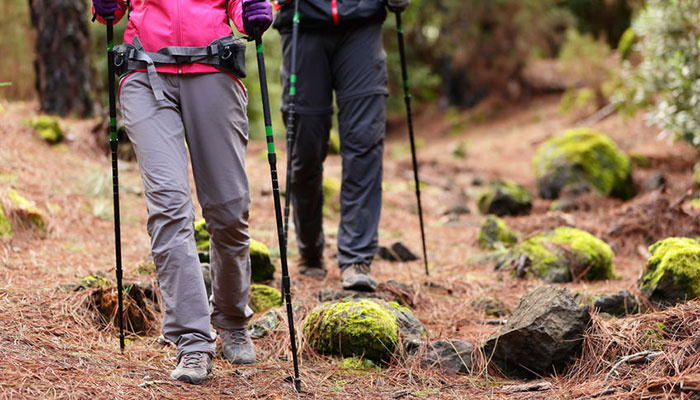
Trekking poles, also called hiking sticks, hiking poles, walking/hiking staff, or walking poles are designed to aid walkers with their rhythm as they walk and to provide stability on rough terrain. Trekking poles today are typically sold as a pair, whereas a walking staff, for example, is a single pole used as a walking aid for those out for a stroll versus those traversing rough terrain.
Usually, trekking poles are adjustable so you can adjust to your height and for stability on any terrain. You would normally shorten the poles when going uphill and lengthen for downhill.
Collapsible poles are easily lashed to a backpack for carrying or storing.
Why Use Trekking Poles
The added weight of the poles propels your arms forward and thus this increase in momentum helps you move better up inclines and will increase your overall walking speed on level terrain, and of course, the poles provide better balance on uneven terrain. Do you expend more energy, yes, you do, but the overall impact is minimal when compared to the added benefits.
The poles have been shown to reduce the impact on your legs, knees, ankles and feet, in particular when going downhill.
Additional Reasons
1.) Brush aside those thorny nuisances that can stab, scratch, and generally cause you to curse to yourself as you move through the brush. Use the poles to brush aside spider webs in your path, poison ivy, and other ground/vegetation hazards that you would rather not touch with your bare hands.
2.) Trekking poles are ideal for those wearing snowshoes to increase speed and to provide better balance, not to mention you can probe for depth and dangers lurking under the snow. For those trekking across glaciers, trekking poles are a necessity to probe ice bridges, for example.
3.) Probe ice covered lakes, rivers, or streams for weak spots with your poles, as well as, provide two extra ground contact points for walking on icy, muddy, and wet surfaces.
4.) Check water depth and make river or stream crossings less hazardous. Use the poles to probe where your eyes can’t see.
5.) Use as you would any tent pole to set up an emergency shelter using tarps. This also cuts down on gear in your pack, if you otherwise carried collapsible tent poles for shelter making.
6.) Use as makeshift splints to immobilize injured limbs.
7.) You can use the poles for self-defense against snakes, and against four legged, and two legged predators alike.
8.) The poles in some cases can be used as a spear for survival fishing, hunting, or self-defense.
9.) Use to secure signal flags so they move in the breeze to catch the eyes of searchers, and secure windsocks so you can estimate wind speed and direction, as well.
10.) Can be used as an ad hoc paddle for a canoe or even a kayak if you wrap the water end in some cloth to increase friction with the water.
11.) Use as a makeshift raft pole to guide a raft or canoe from the standing position.
Quality does count when it comes to trekking poles because you certainly do not want the poles snapping in two when trying a walk down a steep incline, so choose carefully.